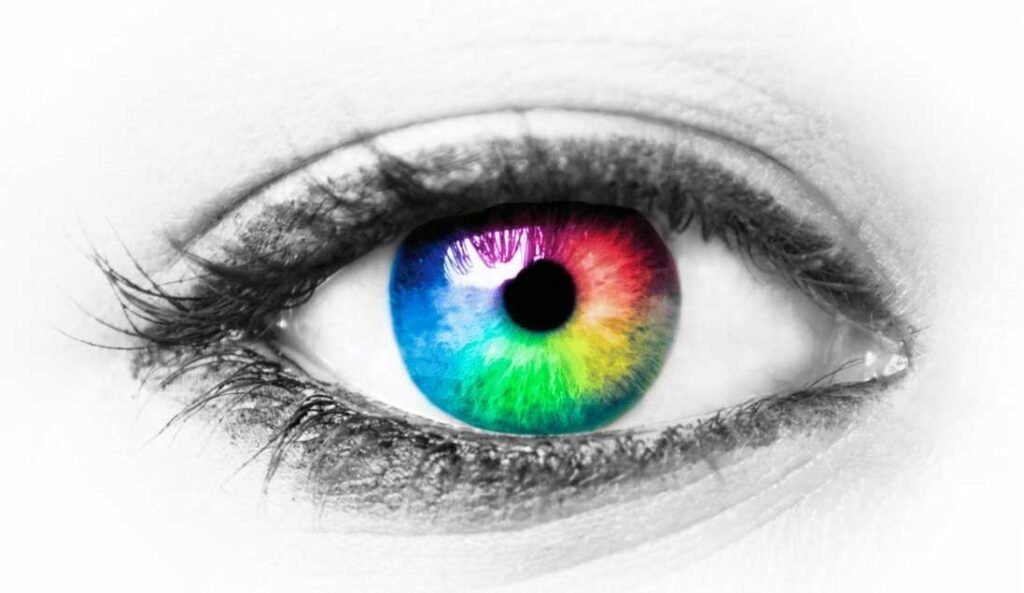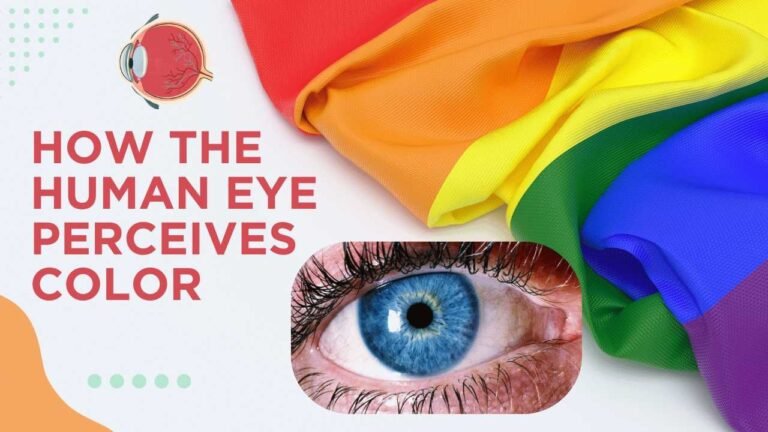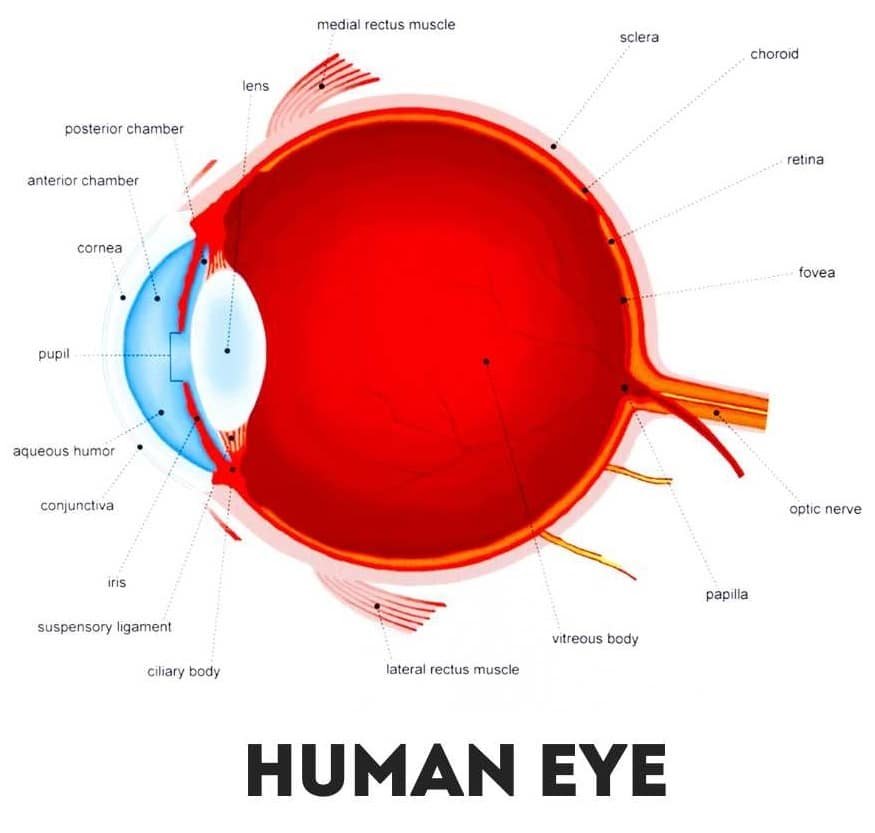Introduction to Color Perception
Color is an important part of our everyday lives. From the blue sky to the green trees, the way we see colors affects how we view and feel about the world. Have you ever wondered how the human eye perceives color ?
Learning about the science of color vision helps us understand the amazing complexity of our eyes and makes us appreciate the beauty of the world even more.

The Importance of Color in Daily Life
Colors affect our emotions, actions, and even our health. Warm colors like red and yellow can energize us, while cool colors like blue and green can calm us.
Marketers use colors in branding to influence our choices, and artists use them to express feelings. Understanding how we perceive colors helps us interact with the world better.
A Brief Overview of the Human Eye Structure
The human eye is an incredible example of biological engineering. On the surface, we have the cornea and lens, which focus light.
Inside, the retina contains photoreceptor cells that detect light and color. Finally, the optic nerve carries these signals to the brain, where they are interpreted.
Historical Perspectives on Color Perception
Color vision has fascinated scientists and philosophers for centuries. The ancient Greeks, like Aristotle, believed that colors were made by mixing light and darkness. In the 17th century, Isaac Newton discovered that light could be split into a spectrum of colors with a prism, laying the foundation for our modern understanding of color.
Difference between rods and cones:
- Rods: Each eye has approximately 120 million rods, which are highly sensitive to light and suitable for night vision, but they cannot sense colors.
- Cones: Each eye has approximately 6 million cones that work best in strong light and allow us to see colors.
Types of Cones: Red, Green, and Blue
Cones are divided into three types based on the color they detect:
- Red Cones (L-cones): Sensitive to long wavelengths.
- Green Cones (M-cones): Sensitive to medium wavelengths.
- Blue Cones (S-cones): Sensitive to short wavelengths.
Distribution of Photoreceptor Cells in the Retina
The fovea, a tiny pit in the retina, is densely packed with cones, providing our sharpest vision and best color detection. Rods are more spread out, especially around the edges of the retina, helping us see in low light and detect motion.
The Process of Color Perception
Light Wavelength and Color Detection
Colors represent different wavelengths of light. Red has the longest wavelength, and blue/violet has the shortest. When light reaches the eye, its wavelength determines which cones are activated.
The Journey of Light Through the Eye
Light first passes through the cornea and lens, which focus it onto the retina. The photoreceptor cells in the retina then detect this light and send messages to the brain via the optic nerve.
Signal Transmission to the Brain
When the signals reach the brain, they are processed in the visual cortex, allowing us to perceive different colors.
Color Vision Phenomena and Anomalies
Color Blindness and Its Types
Color blindness happens when one or more types of cones in the eye don’t work properly or are missing. Common types include:
- Red-green color blindness: Difficulty distinguishing between red and green.
- Blue-yellow color blindness: Difficulty distinguishing between blue and yellow.
- Complete color blindness: A rare condition where a person cannot see any colors at all.
The Role of Genetics in Color Vision
Color vision deficiencies are often genetic and can be passed down through families. Men are more likely to be colorblind because the genes responsible for red and green cones are located on the X chromosome.
Illusions and Their Impact on Color Perception
Optical illusions can trick our brains into seeing colors that aren’t really there. This happens when our brain tries to fill in gaps based on context and past experiences.
The Brain’s Interpretation of Color
How the Visual Cortex Processes Colour Information
The visual cortex mixes and analyzes signals from all types of cones to produce the complete range of colors that humans perceive. It also considers context, such as lighting and neighboring hues.
The Effect of Surroundings and Context on Color Perception
Our perception of color might vary depending on the colors around us and the lighting conditions. This is why a color may appear different indoors than outdoors.
The Psychological Impact of Colors
Colors have the ability to impact our emotions and behaviors. Blue, for example, might evoke a sense of tranquility, but red can cause worry or enthusiasm.
Also read – How Propane Refrigerator Works?
Applications and Implications of Color Perception
Color Usage in Design and Daily Life
Color plays a crucial role in design, branding, and art. Companies strategically use colors to evoke emotions and engage customers.
Medical Implications: Diagnosis of Vision Disorders
Understanding color perception is vital for diagnosing and treating vision disorders such as cataracts and macular degeneration. Early detection can significantly improve treatment outcomes.
Technological Innovations Inspired by Human Color Vision
Our knowledge of color perception has driven advancements in technology, such as digital cameras and screens. These innovations mimic the way human eyes perceive and interpret light.
Conclusion and Summary
Recap of Key Points
In this exploration, we delved into the process of how the human eye perceives color, starting from photoreceptor cells to the brain’s interpretation. We discussed the significance of color in our everyday experiences and its implications for technology and health.
Understanding Color Perception is Vital
Understanding color perception is crucial as it enables us to grasp the intricacies of our vision, enhances our daily experiences, and serves as a catalyst for innovation across various domains.
Also read – How Does a Microwave Work to Heat Food?
Frequently Asked Questions (FAQs)
What Causes Color Blindness?
Color blindness is often caused by genetic factors affecting the cones in the retina. Other causes can include eye injuries or diseases.
How Do We Test Color Vision?
Color vision can be tested using Ishihara plates, which are images composed of various colored dots. People with normal vision see one digit, while those with color blindness see another.
Can Color Vision Be Corrected or Enhanced?
Currently, there is no cure for color blindness, but special lenses and apps can help enhance color perception for those affected. Research is ongoing to develop more permanent solutions.
What 3 colors can the human eye detect?
Red, Green, Blue.
The human eye is equipped with three types of cones, enabling us to perceive a specific range of light and thus, the colors on the electromagnetic spectrum, known as the visible light spectrum. These colors are blue, green, and red. However, our visual perception extends beyond these primary colors to encompass a diverse array of hues and tones.What color can humans not see?
Red-green and yellow-blue
Red-green and yellow-blue are labeled as “forbidden colors.” They consist of pairs of hues with light frequencies that naturally cancel each other out in the human eye, making it challenging to perceive them simultaneously.
Having any queries? – Do reach us at info@scivoyage.com












18 thoughts on “The Science of Seeing: How the Human Eye Perceives Color?”
I like this weblog it’s a master piece! Glad I discovered this ohttps://69v.topn google.Raise your business
Thank U So much
Some truly interesting details you have written.Aided me a lot, just what I was looking for : D.
Thanks for sharing. I read many of your blog posts, cool, your blog is very good.
Can you be more specific about the content of your article? After reading it, I still have some doubts. Hope you can help me.
Can you be more specific about the content of your article? After reading it, I still have some doubts. Hope you can help me.
Your point of view caught my eye and was very interesting. Thanks. I have a question for you.
Can you be more specific about the content of your article? After reading it, I still have some doubts. Hope you can help me.
Your article helped me a lot, is there any more related content? Thanks!
I don’t think the title of your article matches the content lol. Just kidding, mainly because I had some doubts after reading the article.
Thanks for sharing. I read many of your blog posts, cool, your blog is very good.
Your point of view caught my eye and was very interesting. Thanks. I have a question for you.
Your article helped me a lot, is there any more related content? Thanks!
I don’t think the title of your article matches the content lol. Just kidding, mainly because I had some doubts after reading the article.
Thanks for sharing. I read many of your blog posts, cool, your blog is very good.
Good web site! I truly love how it is easy on my eyes and the data are well written. I’m wondering how I might be notified when a new post has been made. I have subscribed to your feed which must do the trick! Have a nice day!
Thanks for sharing. I read many of your blog posts, cool, your blog is very good.
Thank you for your sharing. I am worried that I lack creative ideas. It is your article that makes me full of hope. Thank you. But, I have a question, can you help me?